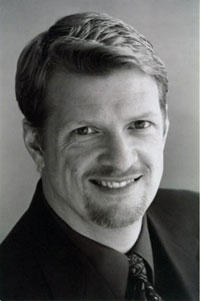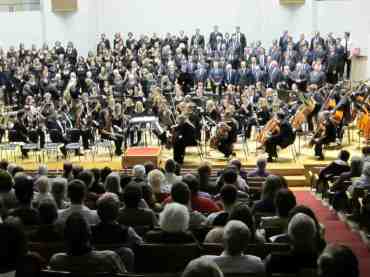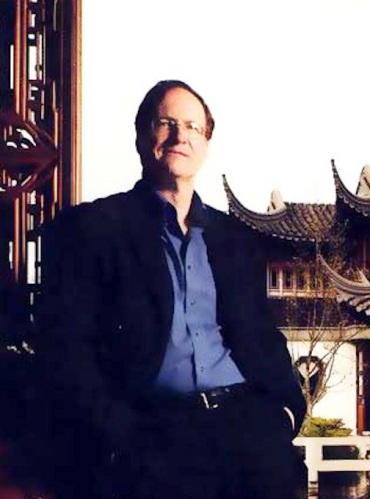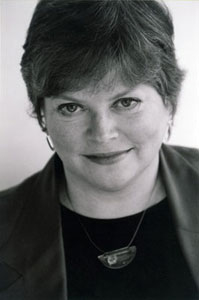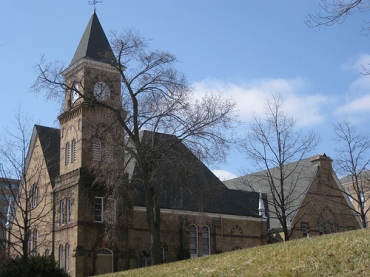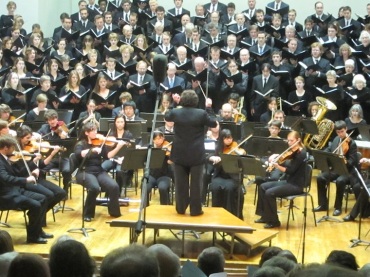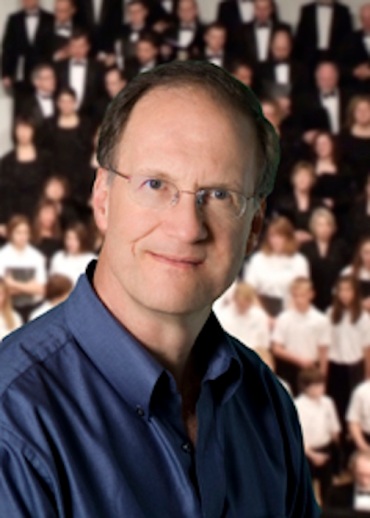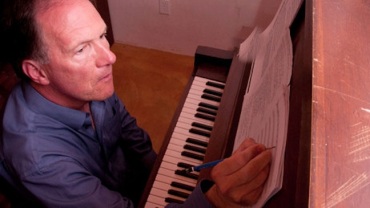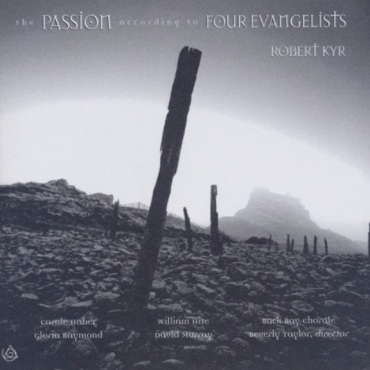The Well-Tempered Ear
Classical music Q&A: American composer Robert Kyr discusses: What should audiences listen for in this weekend’s two performances by the UW Choral Union of his “Passion According to Four Evangelists”? How does the prolific Kyr describe the sound and style of his music? What does he think of his ties to Madison? Part 2 of 2. Plus. the UW Chorale performs a FREE concert Friday night.
Leave a Comment
ALERT: On this Friday, April 26, at 8 p.m. in Mills Hall, the UW-Madison Chorale will perform a FREE and PUBLIC concert under conductor Bruce Gladstone (below, in a photo by Katrin Talbot) with pianist Martha Fischer and student conductor Luke Hrovat-Staedter. Included on the program are John Rutter‘s “The Falcon” as well as works by Handel, Mathais, Hindemith, Ivor Gurney, UW alumnus Lee Hoiby, La Crosse composer Bob Willoughby, and the world premiere of UW alumnus Scott Gendel’s “The Singing Place.” This high-level group of 60 singers performs a varied repertoire. Most singers in Chorale have significant vocal and choral experience, and many are voice majors.
By Jacob Stockinger
This coming weekend will see two performances of Robert Kyr’s “The Passion According to Four Evangelists” by the campus-community UW Choral Union, the UW Chamber Orchestra and four soloists, all under the baton of UW choral director Beverly Taylor.
The soloists are soprano Anna Slate, mezzo-soprano Jennifer D’Agostino, tenor James Doing and baritone Paul Rowe.
The concert are in Mills Hall on Saturday at 8 p.m. and Sunday night at 7:30 p.m. (NOT at 3:30 p.m. as mistkenly first printed in yesterday’s post.) Tickets are $15 for the General Public and $8 for students and seniors. Call the Box Office: (608) 265-2787. Remaining tickets are sold at the door.
Also: The American composer Robert Kyr will do half-hour pre-concert lectures in Mills Hall for TICKETED patrons one hour before each concert. UW students are NOT admitted free to these concerts. Saturday’s lecture 7-7:30 p.m. with the concert at 8 p.m. Sunday’s lecture is 6:30-7 p.m. with the concert at 7:30 p.m.
For background, here is a link to a fascinating NPR story about and interview with Robert Kyr:
The composer — who is personally and artistically committed to social justice and non-violent activism for peace — graciously agreed to an email Q&A with The Ear. Yesterday’s post offered Part 1; here is Part 2.
How would you describe your musical style overall and especially in that work?
My work features what I like to call a “spectrum of harmony” that is primarily consonant, but also dissonant as required for specific expressive purposes.
The engine of my music is counterpoint—the composing of musical line against line. Almost all of my music is an interweaving of melodic lines (in the manner of Bach, for instance), as opposed to the musical currency of our day, which is textural music or homophony (chords, or a melodic line accompanied by chords).
Although I was born in the 20th century, I have always felt (from my teen years onward) that I was a 21st century composer, and I’m more in tune with the eclecticism and vitality of the current 20-something and 30-something composers than my own generation.
In that sense, I am a composer who strives to synthesize many artistic concerns and interests into an organic musical expression. In regard to influences, I am most deeply connected to the music of the medieval, Renaissance and Baroque periods (the “contrapuntal periods”), especially the music of Guillaume Dufay (the isorhythmic motets), Josquin (his motets and masses), and above all, J. S. Bach.
You have worked and partnered with Beverly Taylor (below, in a photo by Katrin Talbot) before. Can you talk about how the two of got to know each other and what you think of her as a performer and interpreter of your works (she has done several, I believe) .
Bev and I met at Harvard University, where she was the director of the Radcliffe Choral Society when I was a doctoral student. She commissioned me to create a work for a cappella women’s chorus for RCS, which was entitled “Toward Eternity.” We became friends through our first collaboration, and shortly thereafter, Bev invited me to create a large-scale work for her Boston community chorus, the Back Bay Chorale.
Together, Bev and I hatched the plan of co-creating The Passion according to Four Evangelists for her ensemble, and she continually inspired me with her insights and wise musical advice. I’m extremely grateful to her for her vision and artistry, and I’m deeply moved by her performances, which convey a profound understanding of the interior life of a musical expression, as well as a complete “living out” of its sonic architecture and emotional depth.
I think you were in Madison for the last performance of this work. Will you be here this time and do you have any impressions of Madison and the UW Choral Union and choral and orchestral programs you would like to share?
Without a doubt, the UW Choral Union is one of the finest choruses in the country and is distinguished by its rich, vibrant, and clear sound, as well as its ability to express the emotional and psychological intricacies of large-scale works. The collaboration of Bev and the chorus is a “marriage made in heaven,” an ideal merging of artistic vision, poetic imagination, and true musical inspiration. (Below is a YouTube video of Kyr discussing his Holocaust Project work “The Unutterable,” which was premiered by Chorus Austin.)
I am thrilled that I’m able to come to Madison — a city that I love —and the University of Wisconsin (my father’s alma mater) for rehearsals and both performances of my Passion. I very much look forward to collaborating again with Bev, the soloists, the Choral Union, and the UW Symphony Orchestra.
Tags: Baton Rouge, Baton Rouge Louisiana, Beverly Taylor, Choir, Four Evangelists, Harvard University, Jacob Stockinger, Johann Sebastian Bach, John Rutter, Lee Hoiby, Madison, Mary, Mary Magdalene, Paul Rowe, Radcliffe Choral Society, Robert Kyr, Scott Gendel, Sunday, University of Wisconsin–Madison, UW Choral Union, YouTube
Classical music Q&A: The prolific American composer Robert Kyr discusses the origin and interpretation of his oratorio “The Passion According to Four Evangelists,” which the UW Choral Union, the UW Chamber Orchestra and four soloists will perform this coming Saturday and Sunday. Part 1 of 2. Plus, FREE opera scenes will be performed Wednesday night at the UW.
6 Comments
ALERT: On Wednesday night, April 24, 7:30 p.m. in Music Hall (below) Opera Workshop will perform a Scene Recital that is FREE and OPEN to the public. The program includes scenes from the following operas: “Hansel and Gretel” by Humperdinck; “La Clemenza di Tito,” “Cosi Fan Tutte” and “Idomeneo” by Mozart; and “The Pearl Fishers” by Bizet. Opera workshop is a semester-long course designed to help the singer improve his or her competency as a singing actor. The student is given a scene from an opera to learn. During the course, the student is coached, assisted with language diction, and given tips on stage directions. At the end of the semester, students perform their pieces in front of an audience. The workshop is considered a safe place for the student to learn and grow as an artist.
By Jacob Stockinger
This coming weekend will see two performances of American composer Robert Kyr’s “The Passion According to Four Evangelists” by the campus-community UW Choral Union (below), the UW Chamber Orchestra and four soloists, all under the baton of longtime UW choral director Beverly Taylor.
The soloists are soprano Anna Slate, mezzo-soprano Jennifer D’Agostino, tenor James Doing and baritone Paul Rowe.
The concerts are in Mills Hall on Saturday at 8 p.m. and on Sunday night at 7:30 p.m. (NOT 3:30 p.m.as mistakenly printed first). Tickets are $15 for the General Public and $8 for Students and Seniors. The UW Box Office can be reached at (608) 265-2787. Remaining tickets are sold at the door.
Also: The American composer Robert Kyr will do half-hour pre-concert lectures in Mills for TICKETED patrons one hour before each concert. UW students are not free to these concerts. Saturday’s lecture 7-7:30 p.m. with the concert at 8 p.m. Sunday’s lecture is 6:30-7 p.m. with the concert at 7:30 p.m.
For background, here is a link to a fascinating NPR story about and interview with Robert Kyr and to Kyr’s own website:
The composer (below) — who is deeply committed to social justice and peace activism — graciously agreed to an email Q&A with The Ear:
Could you briefly introduce yourself and your work and career, and where the Passion According to Four Evangelists fits in?
I am a composer, writer and filmmaker who has composed 12 symphonies, three chamber symphonies, three violin concertos, chamber music, and more than 80 works for vocal ensembles of all types (with and without instruments).
Within the past two decades, most of my works explore a wide variety of topics from an intercultural perspective: Spiritual Themes (The Passion according to Four Evangelists, Songs of the Soul, and The Cloud of Unknowing); Conflict and Reconciliation, as well as Peace-Making (Symphony No. 9—The Spirit of Time, Symphony No. 10— Ah Nagasaki: Ashes into Light, The Unutterable, and Waging Peace, which is based on first person witness testimony of the citizens of Baton Rouge about violence in their city); and Living in Harmony with Nature, preserving our environment (A Time for Life, an environmental oratorio, and Symphony No. 11—Yosemite: Journey of Light, a multimedia symphony).
I am the chair of the composition department at the University of Oregon School of Music and Dance, where I also direct three musical organizations: the Oregon Bach Festival Composers Symposium, the Music Today Festival, and the Vanguard Concert and Workshop Series. Currently, I am also the President of our University Senate, which involves doing quite a bit of mediation, as an endeavor of peace-making. (A performance of Robert Kyr’s “Now Is the TIme” is in a YouTube video at the bottom.)
What are your current and future projects and plans?
Immediately following the performances of The Passion according to Four Evangelists, I will go directly to Baton Rouge, Louisiana, for the rehearsals and premiere of a work that I finished in the past few months, Waging Peace for 6 actors and actresses, soprano and baritone soloists, a chorus of 120 singers, and an instrumental ensemble. The text is based on first-person witness accounts of the citizens of Baton Rouge about the plague of violence in their city. It was written as part of a workshop that I gave there, which resulted in 400 pages of testimony that is anguished and often terrifying, yet ultimately hopeful.
In our relentlessly violent era, I believe that music and the arts have a significant role to play as part of our individual and collective healing process. I have co-created Waging Peace with the citizens of Baton Rouge as a testament to the power of the human spirit to overcome even the most extreme adversity.
On quite a different note, at the end of May, I will travel to Austin, Texas, to work with Craig Hella Johnson and his remarkable ensemble, Conspirare Company of Voices. They will perform an entire concert of my music, consisting of two works—The Cloud of Unknowing and Songs of the Soul, which explores the theme of love from a variety of perspectives. It includes texts by St. Teresa of Avila and St. John of the Cross — the former was the spiritual mentor of the latter — as well as Psalm texts and excerpts from “The Cloud of Unknowing,” a guide to contemplation of the Divine by an anonymous 14th-century monk. Following their two concerts, Craig and Conspirare will record both of my works for the Harmonia Mundi record label. (Below is a photo Robert Kyr composing at a piano.)
What was the inspiration behind The Passion according to Four Evangelists?
In setting the passion text, I wanted to emphasize the universality of the story. As a narrative, it is neither doctrine nor dogma, but rather, a story told collaboratively by four individuals who emerge from “the community” as represented by the chorus.
In The Passion according to Four Evangelists, the story of Christ’s suffering and death is told from the differing viewpoints of the four gospel narrators, who join together to present a composite version of it.
The roles of Matthew, Mark, Luke, and John are sung by four soloists — soprano, alto, tenor, and baritone, respectively — and the shared parts of the story are set as duos, trios and quartets.
Unexpectedly, the most prominent evangelist roles—Matthew and Mark—are sung by the soprano and alto, which reverses the oratorio and opera tradition of giving women’s roles to men. In addition, each soloist also takes the part of a principal character in the drama: the soprano and alto represent Mary and Mary Magdalene in the Stabat Mater (Mary Stood Weeping); the tenor is Jesus; and the baritone is Pilate. In this way, the evangelists narrate a story that they enact, as well.
My intention to emphasize the universal qualities of the passion involves the issue of gender, as well. In The Passion according to Four Evangelists, the role of women is highlighted by prominently featuring them in two pivotal scenes—Daughters of Jerusalem (scene 3 of Part II, the central scene of The Way of the Cross) and Witness (the final scene of Part III).
In Witness, the passion concludes with an intense tableau in which the soprano and alto soloists sing Psalm 88, a psalm of desolation, while the women’s chorus (accompanied by violins and violas only) repeats a phrase from the Latin Stabat Mater text—“stabat mater lacrimosa”…Mary stood weeping.” This scene focuses on the women standing at the cross who mourn the death of Jesus.
These final moments of the work are a musical pièta expressing the lamentation of Jesus’ mother and friends. As the Stabat Mater finishes, the circle of mourners expands to include all of humanity, as represented by the full chorus (SATB), which sings the De Profundis: “Out of the Depths, I cry to you, O Lord”, followed by an epilogue that foreshadows the resurrection.
Tomorrow: Part 2 — What should the audience listen for in this weekend’s performances by the UW Choral Union of Robert Kyr’s “The Passion according to Four Evangelists”? How does the composer describe the sound and style of his music? What does he think of his ties to Madison?
